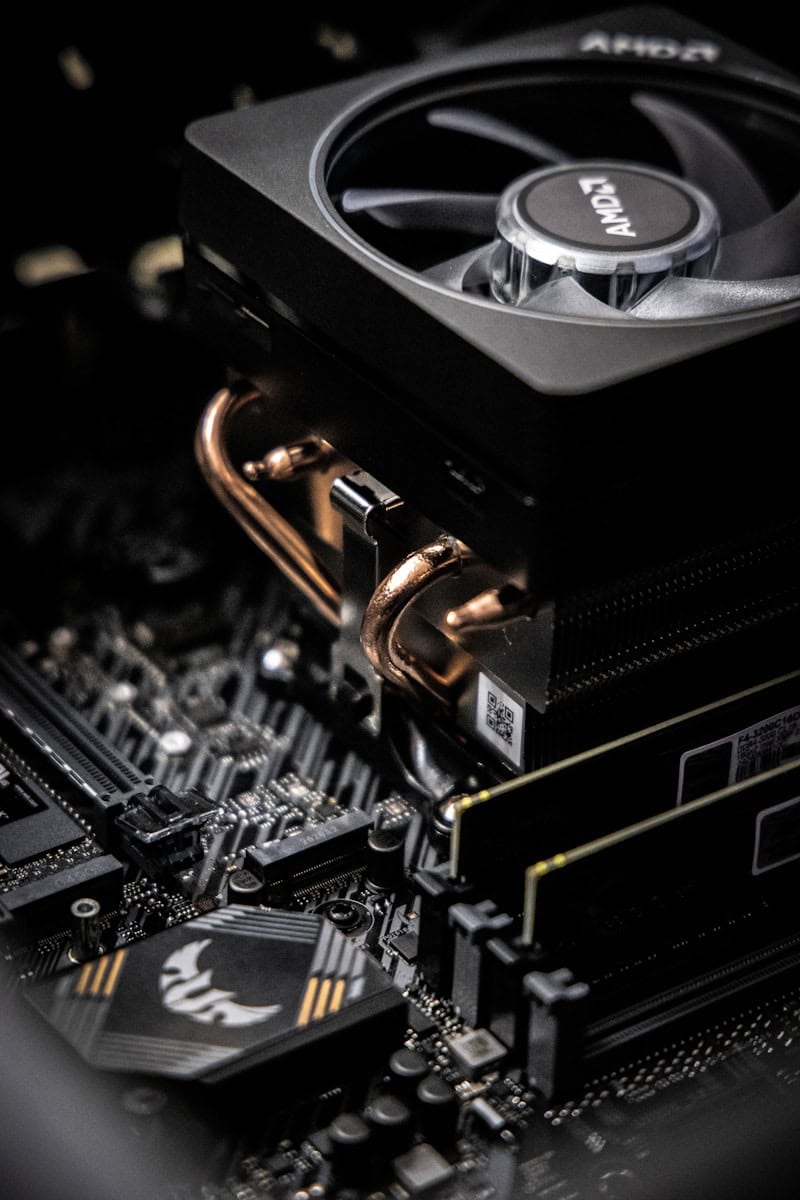Installing a CPU cooler correctly is crucial for your computer’s performance and longevity. Getting the right screw tightness can seem tricky, but it’s simpler than you might think. You should tighten CPU cooler screws until they’re snug, but not so tight that you’re straining or risking damage to the motherboard.
When installing your cooler, apply a small amount of thermal paste to the CPU. This helps transfer heat from the processor to the cooler. Then, place the cooler on top and start screwing it down. Use a diagonal pattern, tightening each screw a little at a time. This ensures even pressure across the CPU.
You’ll know you’ve reached the right tightness when the screws stop turning easily. Don’t force them further – this could warp the motherboard or damage the CPU. If your cooler has spring-loaded screws, they’ll automatically stop at the correct pressure. Remember, the goal is secure contact for efficient cooling, not maximum tightness.
| Screw Tightness | Effect |
|---|---|
| Too loose | Poor heat transfer, cooler may shift |
| Just right | Optimal cooling, secure fit |
| Too tight | Risk of damage to CPU or motherboard |
Finding the Sweet Spot: How Tight Should You Screw Your CPU Cooler?
Installing a CPU cooler seems simple enough, but one question often arises: how tight should you screw it down? Overtightening can damage your components, while undertightening can lead to poor cooling. Here’s a guide to help you find the right balance.
Why Proper Tightness Matters
The pressure from the cooler helps create optimal contact between the CPU heat spreader and the cooler’s base. This ensures efficient heat transfer, preventing your CPU from overheating. However, excessive pressure can damage the motherboard or even the CPU itself.
General Guidelines
- Even Pressure: Tighten the screws gradually and evenly in a crisscross pattern. This ensures uniform pressure distribution.
- Stop at Resistance: When you feel resistance, stop turning the screw. Don’t force it beyond this point.
- Avoid Overtightening: Overtightening can warp the motherboard or damage the CPU. It’s better to err on the side of slightly loose than too tight.
- Consult Your Manual: Refer to your cooler’s installation manual for specific instructions and torque specifications, if provided.
Specific Cooler Types
- Screw-down Coolers: These are the most common type. Follow the general guidelines above, tightening the screws gradually and evenly.
- Bolt-through Kits: These kits use bolts that go through the motherboard. Ensure you use the correct standoffs and backplate to avoid putting excess pressure on the motherboard.
- LGA Sockets (Intel): Intel’s LGA sockets have a lever mechanism to secure the cooler. Ensure the lever is fully engaged after placing the cooler.
Signs of Incorrect Tightness
- Overtightening: You might see the motherboard bending around the cooler, or you might hear cracking sounds. If this happens, loosen the screws immediately.
- Undertightening: Your CPU might overheat under load. Monitor your CPU temperatures using monitoring software.
Tips for CPU Cooler Installation
| Tip | Description |
|---|---|
| Use a screwdriver with a good grip | This helps you control the pressure and avoid slipping. |
| Don’t overtighten one screw at a time | Tighten all screws gradually in a crisscross pattern. |
| If in doubt, consult online resources | Many videos and guides demonstrate proper CPU cooler installation. |
By following these guidelines and paying attention to the signs of incorrect tightness, you can ensure your CPU cooler is installed correctly for optimal cooling and system stability.
Understanding CPU Cooling and Its Components
CPU cooling is essential for maintaining optimal performance and longevity of your computer’s processor. It involves several key components working together to manage heat dissipation effectively.
Function of a CPU Cooler
A CPU cooler’s main job is to remove heat from the processor. It does this through heat transfer and dissipation. The cooler absorbs heat from the CPU’s surface and moves it away. This process keeps the CPU within safe operating temperatures.
Most coolers use a metal base plate that sits directly on the CPU. This plate conducts heat upwards into a larger heatsink. The heatsink has many thin metal fins. These fins increase the surface area for heat to escape into the air.
A fan often accompanies the heatsink. It blows air across the fins to speed up heat removal. Some advanced coolers use liquid instead of air for more efficient cooling.
Types of CPU Coolers
There are two main types of CPU coolers: air coolers and liquid coolers.
Air coolers use a heatsink and fan combination. They’re simple, reliable, and cost-effective. Air coolers come in various sizes. Larger ones generally offer better cooling performance.
Liquid coolers use a water block, radiator, and pump. The water block sits on the CPU. It circulates coolant to a radiator where heat dissipates. Liquid coolers are often more efficient than air coolers. They’re especially useful in small cases or for overclocked CPUs.
| Cooler Type | Pros | Cons |
|---|---|---|
| Air Cooler | Affordable, Easy to install | Can be bulky |
| Liquid Cooler | Efficient, Compact | More expensive, Risk of leaks |
When choosing a CPU cooler, consider your CPU model, case size, and budget. Proper installation is key for any cooler type to work effectively.
Preparing for CPU Cooler Installation
Proper preparation is key for a successful CPU cooler installation. You’ll need the right tools and materials to ensure a secure fit and optimal thermal performance.
Selecting the Right Tools
You’ll need a Phillips head screwdriver that fits your cooler’s screws. Choose a magnetic-tipped screwdriver to prevent dropped screws. Some coolers come with their own tool, so check the package first.
Keep a pair of needle-nose pliers handy for tight spaces. They can help grasp small screws or parts if needed.
A clean, lint-free cloth is essential for wiping the CPU and cooler surfaces. This removes any dust or residue before applying thermal paste.
Organize your workspace with good lighting. A small container can hold loose screws and prevent loss.
Applying Thermal Paste
Thermal paste improves heat transfer between the CPU and cooler. Clean both surfaces with isopropyl alcohol and the lint-free cloth before applying.
Most pastes come in a syringe. Apply a small pea-sized dot to the center of the CPU. Don’t spread it – the cooler’s pressure will do that for you.
Too much paste can hinder performance. A thin layer is best. If you make a mistake, clean and start over.
Some coolers have pre-applied paste. If so, don’t add more unless instructed.
| Paste Type | Pros | Cons |
|---|---|---|
| Silver-based | High conductivity | Expensive, can be conductive |
| Ceramic-based | Non-conductive, affordable | Lower thermal performance |
| Carbon-based | Good performance, non-conductive | Mid-range price |
Choose a paste that fits your needs and budget. Apply carefully for the best cooling results.
Securing the CPU Cooler Properly
Proper installation of a CPU cooler is crucial for optimal performance and longevity of your computer. Correct tightening techniques ensure even pressure distribution and efficient heat dissipation.
Tightening Screws Incrementally
Start by positioning the CPU cooler squarely on the processor. Diagonal tightening is key for even pressure. Begin with opposite corners, giving each screw a few turns.
Move to the remaining screws, repeating the process. Tighten in small increments, making several passes. This method prevents warping and ensures uniform contact.
Many coolers use spring-loaded screws. These help regulate pressure and reduce the risk of overtightening. Stop when you feel resistance from the springs.
| Tightening Step | Action |
|---|---|
| 1 | Position cooler |
| 2 | Start diagonal corners |
| 3 | Tighten incrementally |
| 4 | Make multiple passes |
Avoiding Common Mistakes
Overtightening is a frequent error. It can damage the motherboard or CPU. Aim for snug, not ultra-tight. The cooler should be secure without strain.
Uneven contact is another pitfall. Check that the cooler sits flat on the CPU. Uneven pressure can lead to hot spots and poor cooling.
Don’t forget thermal paste. Apply a small amount before mounting the cooler. Too much can hinder heat transfer.
Lastly, watch for loose cables. Ensure fan wires don’t interfere with the cooler’s contact or movement. Proper cable management prevents vibrations and improves airflow.
After Installation: Ensuring System Stability
Proper CPU cooler installation is crucial for system stability and performance. Regular checks and adjustments help maintain optimal cooling efficiency.
Checking for Overheating
Monitor your CPU temperatures after installing the cooler. Use software like Core Temp or HWMonitor to track thermal readings. Normal idle temperatures range from 30-40°C, while full load should stay below 80°C for most CPUs.
Watch for signs of overheating:
- Sudden shutdowns
- Blue screens
- Performance drops
If temperatures are too high, check the cooler’s contact with the CPU. Ensure it’s securely fastened and thermal paste is applied correctly.
Run stress tests to simulate heavy loads. Prime95 or AIDA64 can help identify thermal issues. Monitor temps during these tests to spot potential problems.
Adjustments for Optimal Performance
Fine-tune your cooling setup for the best results. Adjust fan speeds through BIOS or software controls. Aim for a balance between cooling performance and noise levels.
Consider your case airflow:
- Ensure proper intake and exhaust
- Remove dust regularly
- Cable management for better air circulation
| Adjustment | Purpose | Benefit |
|---|---|---|
| Fan curve | Control speeds | Balance noise and cooling |
| Case fans | Improve airflow | Lower overall temps |
| Thermal paste | Better heat transfer | Reduced CPU temps |
If temperatures remain high, recheck the tightness of cooler screws. Don’t overtighten, as this can damage components. Follow manufacturer guidelines for torque specifications.
Optimize your system’s power settings. Adjust Windows power plan or BIOS settings to manage CPU performance and heat output effectively.
Frequently Asked Questions
Installing a CPU cooler correctly is crucial for your computer’s performance and longevity. Proper tension and even mounting are key factors to consider. Let’s address some common questions about CPU cooler installation.
What is the proper tension for installing a heatsink?
Tighten the screws gently until they stop. Don’t use excessive force. This ensures good contact between the cooler and CPU without risking damage.
Aim for firm but not overly tight pressure. The cooler should feel securely attached without any wobble.
What are the symptoms of an improperly seated CPU?
An improperly seated CPU can cause various issues. You might experience frequent system crashes or unexpected shutdowns.
High CPU temperatures, even at idle, can indicate poor contact with the cooler. Your computer may also fail to boot or display error messages related to CPU detection.
Is there a recommended torque for CPU cooler screws?
Most cooler manufacturers don’t specify an exact torque value. Noctua suggests not exceeding 0.6 Nm for their standard mounting screws.
Hand-tightening is usually sufficient. If you’re unsure, consult your cooler’s manual for specific guidance.
How do you ensure a CPU cooler is mounted evenly?
To mount a CPU cooler evenly, follow a diagonal pattern when tightening the screws. Start with opposite corners and alternate.
Tighten each screw partially, then move to the next. Gradually increase pressure across all screws until they’re secure.
Can tightening a CPU cooler too much cause damage?
Yes, overtightening can damage your CPU or motherboard. Excessive pressure may crack the CPU die or warp the motherboard.
It can also lead to uneven contact, reducing cooling efficiency. Always use gentle pressure and stop when you feel resistance.
What is the correct installation tightness for an AMD stock cooler?
AMD stock coolers typically use a lever or latch mechanism. Secure the cooler until the lever clicks into place.
For screw-based AMD coolers, follow the same principles as other coolers. Tighten until firm but not overly tight.
| Cooler Type | Tightening Method | Tips |
|---|---|---|
| Screw-based | Hand-tighten gently | Stop when resistance is felt |
| Lever/Latch | Secure until it clicks | Ensure even pressure |
| Push-pin | Press until pins click | Check all corners are secure |







